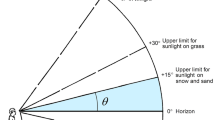Abstract
Cloud and solar zenith angle (SZA) are two major factors that influence the magnitude of the biologically damaging UV (UVBD) irradiances for humans. However, the effect on the short wavelength cut-off due to SZA and due to clouds has not been investigated for biologically damaging UV for cataracts. This research aims to investigate the influence of cloud and SZA on the short wavelength cut-off of the spectral UVBD for cataracts. The spectral biologically damaging UV for cataracts on a horizontal plane was calculated by weighting the spectral UV measured with a spectroradiometer with the action spectrum for the induction of cataracts in a porcine lens. The UV spectra were obtained on an unshaded plane at a latitude of 29.5° S. The cut-off wavelength (λc) was defined as the wavelength at which the biologically damaging spectral irradiance was 0.1% of the maximum biologically damaging irradiance for that scan. For the all sky conditions, the short wavelength cut-off ranged by 12 nm for the SZA range of 5 to 80° and the maximum in the spectral UVBD ranged by 15 nm. Similarly, for the cloud free cases, the short wavelength cut-off ranged by 9 nm for the same SZA range. Although, cloud has a large influence on the magnitude of the biologically damaging UV for cataracts, the influence of cloud on the short wavelength cut-off for the biologically damaging UV for cataracts is less than the influence of the solar zenith angle.
Similar content being viewed by others
References
S. K. West, D. D. Duncan, B. Munoz, G. S. Rubin, L. P. Fried, K. Bandeen-Roche and O. D. Schein, Sunlight exposure and the risk of lens opacities in a population based study JAMA-J. Am. Med. Assoc. 1998 280 714–718.
B. T. Smith, S. Belani and A. C. Ho, Ultraviolet and near-blue light effects on the eye Int. Ophthalmol. Clin. 2005 45 107–115.
R. W. Young, The family of sunlight-related eye diseases Opt. Visual Sci. 1994 712 125–144.
M. S. Oliva and H. Taylor, Ultraviolet radiation and the eye Int. Ophthalmol. Clin. 2005 45 1–17.
H. R. Taylor, The biological effects of UV-B on the eye Photochem. Photobiol. 1989 504 489–492.
J. Dillon, L. Zheng, J. C. Merriam and E. R. Gaillard, The optical properties of the anterior segment of the eye: Implications for cortical cataract Exp. Eye Res. 1999 68 785–795.
D. Balasubramanian, Photodynamics of cataract: an update on endogenous chromophores and antioxidants Photochem. Photobiol. 2005 81 498–501.
D. Balasubramanian, Ultraviolet radiation and cataract J. Ocul. Pharmacol. Ther. 2000 16 285–297.
O. M. Oriowo, A. P. Cullen, B. R. Chou and J. G. Sivak, Action spectrum and recovery for in vitro UV-induced cataract using whole lenses Invest. Ophthalmol. Visual Sci. 2001 42 2596–2602.
A. V. Parisi and N. Downs, Cloud cover and horizontal plane eye damaging solar UV exposures Int. J. Biomet. 2004 49 130–136.
J. M. Sabburg, A. V. Parisi and M. G. Kimlin, Enhanced spectral UV irradiance: a one year preliminary study Atmos. Res. 2003 664 261–272.
A. V. Parisi and N. Downs, Variation of the enhanced biologically damaging solar UV due to clouds Photochem. Photobiol. Sci. 2004 3 643–647.
D. H. Sliney, Geometrical assessment of ocular exposure to environmental UV radiation J. Epidemiol. 1999 9 S22–S32.
A. V. Parisi, A. Green and M. G. Kimlin, Diffuse solar ultraviolet radiation and implications for preventing human eye damage Photochem. Photobiol. 2001 732 135–139.
N. Kollias, A. H. Baqer, H. Ou-Yang, Diurnal and seasonal variations of the UV cut-off wavelength and most erythemally effective wavelength of solar spectra Photodermatol. Photoimmunol. Photomed. 2003 19 89–92.
J. Sabburg and C. N. Long, Improved sky imaging for studies of enhanced UV irradiance Atmos. Chem. Phys. 2004 4 2543–2552.
Author information
Authors and Affiliations
Corresponding author
Rights and permissions
About this article
Cite this article
Parisi, A.V., Turner, J. Variations in the short wavelength cut-off of the solar UV spectra. Photochem Photobiol Sci 5, 331–335 (2006). https://doi.org/10.1039/b512029b
Received:
Accepted:
Published:
Issue Date:
DOI: https://doi.org/10.1039/b512029b




